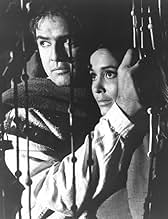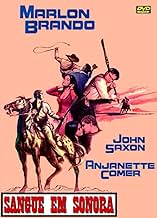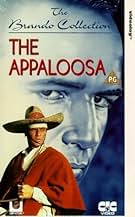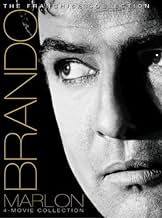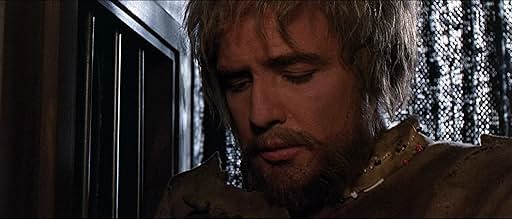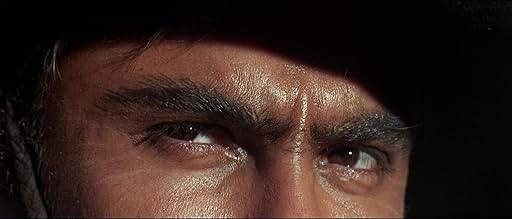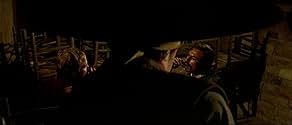NOTE IMDb
6,3/10
3,8 k
MA NOTE
Un homme tente de récupérer son cheval qu'un bandit mexicain lui a soustrait.Un homme tente de récupérer son cheval qu'un bandit mexicain lui a soustrait.Un homme tente de récupérer son cheval qu'un bandit mexicain lui a soustrait.
- Réalisation
- Scénario
- Casting principal
- Récompenses
- 1 victoire et 1 nomination au total
Emilio Fernández
- Lazaro
- (as Emilio Fernandez)
Argentina Brunetti
- Yaqui Woman
- (non crédité)
Debra Domasin
- Paquita
- (non crédité)
Abel Fernandez
- Mexican Farmer
- (non crédité)
Raven Grey Eagle
- Minor Role
- (non crédité)
Avis à la une
This film seems to be caught between the 1950s western movies and the Spaghetti Westerns later in the 60s. While the 1950s hero drawn into conflict was 'minding his own business and wanted to be left alone', once crossed the bad guy found he woke a sleeping giant. Perhaps this style was how America saw itself after Pearl Harbor.
"The Appaloosa", on the other hand, has a different style. While Brando was minding his business before being drawn into conflict, the theft of his horse occurs while he is drunk and unable handle the situation, and he seems to be inept. It is a long scene and one that ends in humiliation for Brando's character. Even if a 1950s hero was caught off guard while being drunk, he wasn't humiliated. A 1950s hero would not appear inept, just that he had made a mistake that allowed the bad guy to get the upper hand.
There are other instances in the film where Brando's character doesn't act as a 1950s hero: his ridiculous Mexican accent, his initial plan at the gang's hideout to leave with his horse, his arm-wrestling scene, his reluctance to take revenge. Brando's character was more in style of the 60s make-the-hero-more-realistic and less larger-than-life. He doesn't win all the battles. There is nothing wrong with this, as long as you interested in watching this.
I was fine with it. I did like the final gun battle as it was different from the usual face-to-face shootout.
I had problems with Brando's mumbling. His character didn't seem laconic, but someone who couldn't express himself. While he did have some good lines, other times he seemed to ramble.
The "in disguise at the bar" scene should have been cut. The conversation left me confused and the fake Mexican accent was irritating. This scene only served to introduce one of the outlaw gang members and could have been done another way.
I enjoyed the scenery, that Brando's character was a religious man without it being central to the movie, his intelligence in the final gun battle, and the motivations being believable for the conflict: the bad guy's pride and standing before his gang, and Brando's need for this horse in his future plans.
"The Appaloosa", on the other hand, has a different style. While Brando was minding his business before being drawn into conflict, the theft of his horse occurs while he is drunk and unable handle the situation, and he seems to be inept. It is a long scene and one that ends in humiliation for Brando's character. Even if a 1950s hero was caught off guard while being drunk, he wasn't humiliated. A 1950s hero would not appear inept, just that he had made a mistake that allowed the bad guy to get the upper hand.
There are other instances in the film where Brando's character doesn't act as a 1950s hero: his ridiculous Mexican accent, his initial plan at the gang's hideout to leave with his horse, his arm-wrestling scene, his reluctance to take revenge. Brando's character was more in style of the 60s make-the-hero-more-realistic and less larger-than-life. He doesn't win all the battles. There is nothing wrong with this, as long as you interested in watching this.
I was fine with it. I did like the final gun battle as it was different from the usual face-to-face shootout.
I had problems with Brando's mumbling. His character didn't seem laconic, but someone who couldn't express himself. While he did have some good lines, other times he seemed to ramble.
The "in disguise at the bar" scene should have been cut. The conversation left me confused and the fake Mexican accent was irritating. This scene only served to introduce one of the outlaw gang members and could have been done another way.
I enjoyed the scenery, that Brando's character was a religious man without it being central to the movie, his intelligence in the final gun battle, and the motivations being believable for the conflict: the bad guy's pride and standing before his gang, and Brando's need for this horse in his future plans.
"The Appaloosa" is a superior low-key western with a great performance by Marlon Brando and very good ones by John Saxon and Anjanette Comer. Brando plays a white man raised by Mexicans who returns from the Civil War tired of killing and ready to build a ranch around one Appaloosa stallion. Brando has the misfortune of becoming a tool for Comer to escape the clutches of Saxon. Saxon retaliates by stealing Brando's stallion, and Brando follows Saxon into Mexico to reclaim it. Director Sidney J. Furie ("The Ipcress File," "Iron Eagle") extensively uses extreme close-ups of faces, in the same manner as Sergio Leone, but not for the same purpose. Furie uses these close-ups to establish intimacy between the characters and the audience. This works beautifully in "The Appaloosa," particularly so since the story is so unremarkable and low-key and Brando's character is by no means a superman. Most of the violence is of the "G" rated variety, with the notable exception of a hand-wrestling contest played with the addition of scorpions.
While the ending of "The Appaloosa" is as abrupt and unremarkable as everything that precedes, intimate moments in the movie linger long after. As examples:
o Brando's confessional o The little girl telling Brando he smells like a goat o The goat herder telling Brando about Saxon's gunmen killing his pet goat o Comer telling Brando her fate if he doesn't help her escape Saxon o The hand-wrestling contest
There are many more unremarkable but somehow memorable moments in the sublime "Appaloosa." It is too insignificant to be great, but it most certainly very good. I give "The Appaloosa" an "8".
While the ending of "The Appaloosa" is as abrupt and unremarkable as everything that precedes, intimate moments in the movie linger long after. As examples:
o Brando's confessional o The little girl telling Brando he smells like a goat o The goat herder telling Brando about Saxon's gunmen killing his pet goat o Comer telling Brando her fate if he doesn't help her escape Saxon o The hand-wrestling contest
There are many more unremarkable but somehow memorable moments in the sublime "Appaloosa." It is too insignificant to be great, but it most certainly very good. I give "The Appaloosa" an "8".
I caught this on television and loved it. It's Brando's spaghetti western. Lots of fantastic landscapes. close-ups and acting. Not very violent, but extremely effective. Great soundtrack, would be awesome in surround, but mono track was terrific. John Saxon was a great bad guy ( a Mexican, no less) and character actors are authentic. Well worth seeing. Sidney J. Furie shows real skill as a director even though he was only thirty three at the time. There's elements of John Ford, Howard Hawkes and Sergio Leone. Sometimes it was hard to buy Brando in this role, it's more an Eastwood type of role, but he's such a great actor that he becomes convincing. John Saxon playing a Mexican bandit is a terrific performance, even though it's a white guy playing a Mexican. Hollywood at it's best.
E.Forster Toronto, Canada
E.Forster Toronto, Canada
Marlon Brando would display masochistic tendencies in his sixties parts.His self-directed movie (excellent in other respects),"one-eyed jacks" featured a very long scene where he was whipped by his "Streetcar named desire" pal Karl Malden.In the underrated "reflection in a golden eye" ,he was humiliated by his wife (Elizabeth Taylor).And I will not even mention his beating up in Penn's "the chase":it has to be seen to be believed.
"The Appaloosa " features this kind of scene :it's John Saxon's turn to play the torturer this time.And if it is not clear enough,the movie begins with confession and penance in a church.
The plot of "the Appaloosa" is very simple probably too simple for its own good.Saxon steals Brando's horse and the latter who was about to start a clean brand new life has to fight against that cruel Mexican -Saxon's face and voice desperately try to sound Mexican- whose favorite pastime is arm-wrestle over a scorpion.And he treats his woman bad ,a woman who used to dream of a romantic wedding with priest and walk down the aisle.
The landscapes are nicely filmed but the story is never really exciting.This era was a hard time for Brando whose career seemed shriveled.But it wasn't of course.
"The Appaloosa " features this kind of scene :it's John Saxon's turn to play the torturer this time.And if it is not clear enough,the movie begins with confession and penance in a church.
The plot of "the Appaloosa" is very simple probably too simple for its own good.Saxon steals Brando's horse and the latter who was about to start a clean brand new life has to fight against that cruel Mexican -Saxon's face and voice desperately try to sound Mexican- whose favorite pastime is arm-wrestle over a scorpion.And he treats his woman bad ,a woman who used to dream of a romantic wedding with priest and walk down the aisle.
The landscapes are nicely filmed but the story is never really exciting.This era was a hard time for Brando whose career seemed shriveled.But it wasn't of course.
I'd seen this film years ago, and rented the video last night. Brando was at the zenith of his career:
strong, vital, and fit. His understated, controled acting along with his easy interaction with the other actors made this film a delight to watch. Especially moving was his relationship with Paco (Rafael Campos)-a close bond which was a major force in the film as revealed by the amazing speech relating Mateo's (Brando) growing up in the household of Paco and his family. The scenery was magnificent. A fine western, with qualities that would cross over into any genre.
strong, vital, and fit. His understated, controled acting along with his easy interaction with the other actors made this film a delight to watch. Especially moving was his relationship with Paco (Rafael Campos)-a close bond which was a major force in the film as revealed by the amazing speech relating Mateo's (Brando) growing up in the household of Paco and his family. The scenery was magnificent. A fine western, with qualities that would cross over into any genre.
Le saviez-vous
- AnecdotesAccording to co-star John Saxon, Marlon Brando's relationship with director Sidney J. Furie got to the point where Brando, when getting ready to do a close-up, would be reading a book. He would only lower the book when Furie yelled "Action." When he yelled "Cut," Brando would raise the book again. According to Peter Manso's book on Brando, however, Brando and Furie met years later. Brando was quoted to have said, "I thought you were a no-good double-crosser, and I didn't know if I could trust you, but I saw the film and you have the great sense of the best visual directors. Let's do another movie together." Furie, according to the book, replied, "Never!" Furie, for his part, claims that they only came to blows once on the entire shoot of The Appaloosa (1966).
- GaffesThe Appaloosa which portrays the title character was actually a registered Appaloosa stallion named Cojo Rojo. He was born in 1960 and just prior to being used for the film he was racing on the California tracks. He sired several foals, including several race champions. During filming a few other similarly marked horses were used as stunt horses, but the majority of work was done by Cojo Rojo.
- Citations
[first lines]
Priest: Madam.
[enters confessional booth]
Matt Fletcher: I'm having a little trouble getting started, Father.
Priest: You are in the House of God now, my son. Speak from your heart.
Matt Fletcher: Well, I've done a lot of killin'. I've killed a lot of men and sinned a lot of women. But the men I killed needed killin' and the women wanted sinnin', and well, I never was one much to argue.
- ConnexionsReferenced in Stalingrad (2001)
Meilleurs choix
Connectez-vous pour évaluer et suivre la liste de favoris afin de recevoir des recommandations personnalisées
- How long is The Appaloosa?Alimenté par Alexa
Détails
- Durée1 heure 38 minutes
- Couleur
- Rapport de forme
- 2.35 : 1
Contribuer à cette page
Suggérer une modification ou ajouter du contenu manquant

Lacune principale
By what name was L'Homme de la Sierra (1966) officially released in India in English?
Répondre

